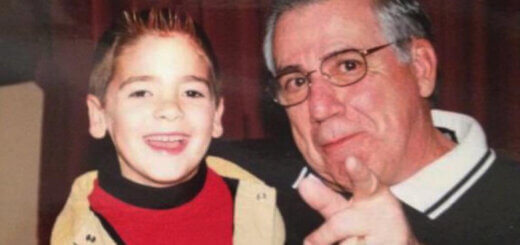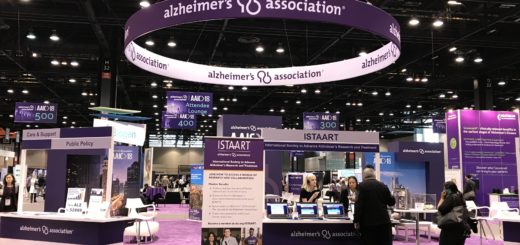Mom advocates for daughter living with Down syndrome and Alzheimer’s
Paula Gann has advocated for her daughter, ever since Kyle was born with Down syndrome. Now that Kyle has developed Alzheimer’s disease, Paula has come out of retirement to ensure that other families have resources to help them in this new journey. Paula volunteers for the Alzheimer’s Association, co-facilitating a telephone support group for caregivers of people living with Down syndrome and Alzheimer’s.
Down syndrome pioneers
Paula Gann, of Manchester, CA, is the mother of three. Her middle child and only daughter, Kyle, was born with Down syndrome (DS) in 1972. Like many parents of children with Down syndrome, advocating for Kyle became an ongoing task for Paula and her husband, Clint.
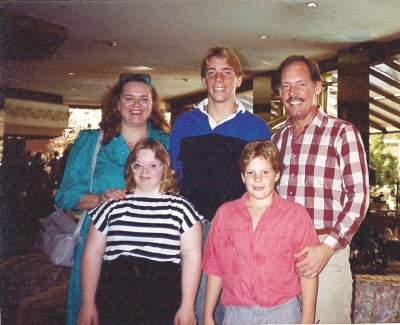
Early in Kyle’s life, Paula and Clint found existing opportunities and worked to create others. Kyle went from the first infant stimulation class offered in Santa Clara County to a Montessori school, to an experimental program for four-year-olds in the public-school system, to special programs in various school districts. It was always left up to them to find the right program at the right time. Unfortunately, Clint did not live to see Kyle leave high school and enroll in a special program at Foothill Community College.
Changes in Kyle
In 2017, Kyle, 45, was withdrawn and depressed due to the sudden end of a serious romantic relationship. She saw a psychiatrist. After that one visit, the psychiatrist called Paula and told her that Kyle had Alzheimer’s disease (AD).
“I was really upset,” said Paula. “It was not the kind of news I wanted to hear. I was totally unaware of co-occurrence” of Alzheimer’s and Down syndrome.
Many adults with DS are living in a supportive environment or group home. Often there are frequent staff changes. New staff don’t know what abilities a person had before. This can make it difficult to know when someone is exhibiting dementia symptoms.
More parental and sibling caregivers
Because children with Down syndrome are more likely to be born to older women, many parents are dealing with their own aging issues, which sometimes includes cognitive impairments.
“I was 28 when I had Kyle,” shared Paula. “Most parents are older when their kids are born with Down syndrome. I’m 76 now. That’s one of the real problems. Often it falls to siblings to manage the situation. They are totally unprepared.” These siblings may also be assisting parents and/or are raising their own children.
Challenges in getting a diagnosis
Initially, many doctors were not aware of the connection between Down syndrome and Alzheimer’s disease (DS&AD). They often attributed the Alzheimer’s symptoms to Down syndrome.
In Kyle’s case, the psychiatrist did know about the co-occurrence. He made an Alzheimer’s diagnosis without testing to rule out other things that could cause the same symptoms. “It’s tough to find doctors that understand the situation and go about making a clear diagnosis,” believes Paula, “instead of jumping to conclusions.”
Not understanding what they have lost
Between changes in staffing and assumptions people make about people living with Down syndrome, it can be challenging for families. They often have to help others understand the impact of AD on their loved ones.
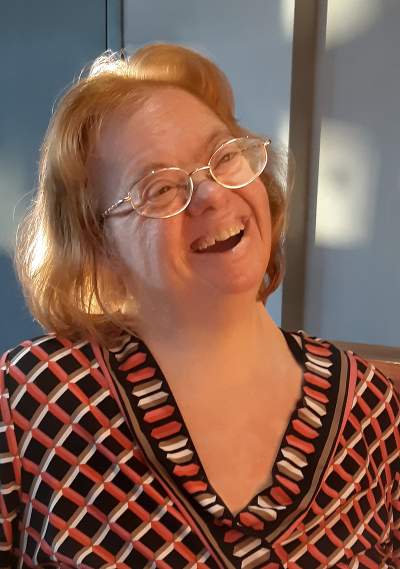
“Providers don’t know what Kyle used to be able to do on her own,” shared Paula. “People don’t know that she used to take three buses to go to college. They just think that what they’re seeing is the way she is and always was. As parents, we have to help people understand what they were and what they have lost” due to Alzheimer’s. Paula feels that is a way to increase compassion for all living with AD.
Learning about Alzheimer’s
With strong connections in the DS community, Paula began to educate herself. She attended DS conventions and conferences, where Alzheimer’s was also discussed.
She connected with the National Task Group on Intellectual Disabilities and Dementia Practices. Through this group she met another caregiver who had cared for her brother when he had DS&AD. “She took my hand and coached me,” shared Paula. “She told me what to do and encouraged me to take a deep breath.”
Staff training needs
Many of the staff working with people with Down syndrome have not had training or experience on Alzheimer’s caregiving. Not long after Kyle was diagnosed with AD, Paula got a call from Kyle’s support staff. She was frustrated because Kyle called the staff person and asked for her phone number. She told Kyle, “you have my phone number, you just called me.” But Kyle kept asking for her number.
“It didn’t take me long to figure out that the people caring for Kyle didn’t know much about Alzheimer’s,” shared Paula. Paula advised the staff person to give Kyle the phone number. “You have to let some things go.”
The National Task Group offers in person training and webinars on DS&AD. To be able to coach Kyle’s caregivers, Paula attended the training in Spokane.
She then reached out the local regional center, community agencies and other parents to bring the training to Silicon Valley. Paula shared that it’s a great training, but it’s hard to get the content to the people who are providing daily care for Kyle and others.
Participating in research
As Paula became more educated about DS&AD, she found a research study at UC Irvine. Kyle and Paula are participating in the National Institute on Aging/National Institutes of Health study of DS&AD.
Nearly all adults over age 40 and all over age 60 who are living with DS have tangles and plaques. But not all go on to develop Alzheimer’s as they age. This study is searching for biomarkers of AD in people living with DS. If they can discover what keeps some people with DS from developing Alzheimer’s, it may help all groups at risk. The Alzheimer’s Association is also funding research among those living with DS&AD.
When Kyle began the study, Paula started to explore whether Kyle had been misdiagnosed. The study clinicians initially diagnosed Kyle with mild cognitive impairment.
Over time, Kyle’s short-term memory has decreased. Paula feels that Kyle may be moving into the early stage of Alzheimer’s.
A desire for continued independence
Kyle has been living independently for 19 years in Santa Clara. She doesn’t want to move in with Paula.
After Kyle was diagnosed, Paula learned that the risk of seizures is higher in persons with DS&AD than in others with AD. Kyle’s service provider has increased staffing so that Kyle has someone with her at home. Kyle also attends a day program. After a seizure in April, Kyle’s doctor prescribed medication, which is helping to prevent future seizures.
Invited to join Governor’s Task Force
Paula was honored to be asked to join the Governor’s Task Force on Alzheimer’s Prevention and Preparedness. Maria Shriver, the Task Force Chair, is aware of the co-occurrence of DS&AD. She ensured that issues facing those with DS would be represented on the Task Force.
Paula hopes to discuss staff training with the Governor’s Task Force. “I am concerned for the caregivers who are serving those with intellectual disabilities and the entire population of people living with Alzheimer’s.” She also acknowledged the projections that there will not be enough caregivers to meet the needs of aging baby boomers.
“We need to establish training and a level of expertise for the caregivers and pay them enough to keep doing this very difficult work,” Paula believes. “Kyle’s caregivers can make more money in other easier jobs. The people who do this work – they deserve a medal.”
Support for rural communities
After an article appeared in the local newspaper on Paula’s appointment to the Task Force, people began reaching out to her. They shared their experiences with the lack of supports and services in rural communities such as Manchester, a town of about 200 people in Mendocino County. Paula intends to share their concerns with the Task Force.
Caregiving tips
Looking back, one of Kyle’s first signs was asking Paula the same question over and over. “I thought she didn’t like my answer and was just trying to drive me nuts, trying to get the answer she wanted,” Paula admits. “Once I knew what was going on, it made a huge difference for me and for her.”
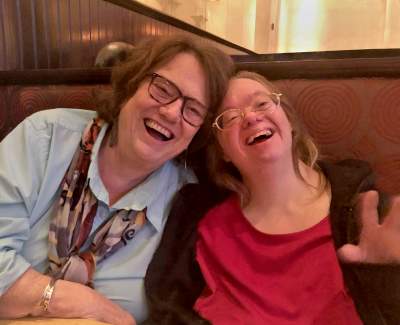
Over time, Paula has realized that it’s most effective to modify her behavior as the caregiver. She finds it helpful to take a deep breath and be calm as she starts a conversation with Kyle.
Paula acknowledges that it can be hard to avoid arguing. When she’s driving in traffic, navigating to an appointment or is otherwise occupied, it can be more difficult to be patient. She asks Kyle to hold her questions until after they arrive at their destination.
“You can’t expect the person with Alzheimer’s to change,” Paula has learned. “That’s the secret to having good quality of life: the people around them need to react differently.”
Connecting with the Alzheimer’s Association
Paula heard about the Alzheimer’s Association through Down Syndrome Connection of the Bay Area. As a former nonprofit leader and someone who is skilled at identifying support, reaching out to the Alzheimer’s Association was a logical step for Paula.
Paula attended education programs offered by the Alzheimer’s Association in the north bay. She learned how her behavior affects Kyle’s reactions. She also connected with support through the NTG and on social media.
Paula has met Alzheimer’s Association staff at national meetings of DS organizations. She saw that the Alzheimer’s Association was interested in supporting families whose loved ones also had DS.
Coming out of retirement
After working as a stay at home mom, in magazine publishing and as a nonprofit executive director, Paula thought that she was going to be able to enjoy her retirement. “Now I’ve hit my fourth career,” says Paula, “advocating for people with intellectual disabilities and Alzheimer’s.”
Paula is co-facilitating a telephone support group with the Alzheimer’s Association and Down Syndrome Connection of the Bay Area. It helps caregivers of those living with DS&AD.
Paula recommends that caregivers reach out for support. “You can’t do it alone, even if the person isn’t living with you. It’s going to burn you out and you’re going to become a person who you don’t want to be,” Paula said. “It’s amazing that there are people who will support you and help you.”
Practicing self-care
Paula knows that it is important for her to take care of herself. She feels fortunate to live in a vibrant community with many activities and friends. She started a play reading group in her community. The group has had to cap their membership, it’s so popular.
She lives by the ocean and takes time to go to the beach. She also feels that her advocacy work helps keep her “alive, active and out of my kids’ hair.” Paula’s two sons also live in the bay area.
Advocating for respect
“It’s really sad. I see how hard Kyle has worked throughout her life to get to where she is, to develop the skills and live independently” shared Paula. “To be hit by this is terrible.”
Paula is on a mission: “I want to help other families know about the co-occurrence so they can be prepared. It’s a hard subject to broach, but it’s so important.”
“There was a time when people like Kyle were put into institutions,” Paula recalled. “Parents were told, “˜don’t take them home.’ We fought that and things changed over time.
“We believe that they deserved to be treated with respect and dignity. Now at the end of her life, I want to see that Kyle continues to be treated with dignity and respect. That’s what I’m advocating for.”
The caregiver support group for caregivers of those living with Down syndrome and Alzheimer’s meets the 3rd Thursday of the month from 6-7 p.m. For more information and to register for the meeting, call Marianne Iversen, 925.362.8660 ext. 103 or email marianne@dscba.org.
Learn more about other caregiver support groups offered by the Alzheimer’s Association, call 800.272.3900 24/7 for information and support.
Learn more:
- Down syndrome and Alzheimer’s
- Alzheimer’s Association 24/7 Helpline
- Alzheimers’ caregiver support groups, including group for caregivers of loved ones with DS&AD
- National Task Group on Intellectual Disabilities and Dementia Practices
- National Down Syndrome Society: Alzheimer’s Disease & Down Syndrome – A Practical Guidebook for Caregivers
- Down Syndrome Scotland: Living with Dementia
- Jenny’s Diary: A resource to support conversations about dementia with people who have an intellectual disability
- My Thinker’s Not Working: A National Strategy for enabling adults with ID affected by Dementia to remain in their community and receive supports
Dr. Brian Chicoine, of the Advocate Adult Down Syndrome Center, and Daniel Kuhn, LCSW, of Rainbow Hospice and Palliative Care, share what caregivers need to know about the connection between Down syndrome and Alzheimer’s disease.





